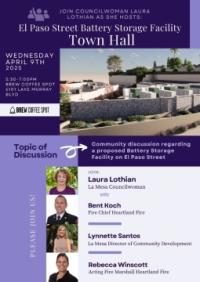

By Miriam Raftery
March 29, 2025 (La Mesa) – La Mesa Councilmember Laura Lothian will host a town hall community discussion on a battery storage facility proposed on El Paso St. The town hall will take place Wednesday, April 9 from 5:30 to 7 p.m. at Brew Coffee Spot, 6101 Lake Murray Blvd.
Heartland Fire Chief Brent Koch, Heartland Acting Fire Marshall Rebecca Winscott, and La Msa Director of Community Development Lynette Santos will also participate in the discussion.
Battery storage facilities are key to expanding renewable energy production such as wind and solar energy, enabling power to be utilized even when the sun doesn’t shine or the wind doesn’t blow.
But lithium ion battery storage facilites have also sparked fires, most notably a fire at a large battery storage site in Otay Mesa, where some nearby businesses had to evacuate for two weeks.
By Karen Pearlman
March 27, 2025 (San Diego’s East County) -- Public water utility entity Helix Water District isn’t just about water – it’s also about energy, power and air.
On Tuesday, the district with roots dating back to 1885 got on board with the future, breaking ground at its El Cajon operations center as part of the district’s transition to a zero-emission vehicle fleet through electrification.
The $11 million electrification project will install nearly 90 high-speed vehicle chargers at the district’s operations center.
By Miriam Raftery
March 25, 2025 (Rancho San Diego) – Today, the Joint Powers Authority (JPA) for the Water Conservation will meet to weigh opens for long-term funding and stability of the Garden at Cuyamaca College.
At its Feb. 25 meeting, the board discussed future funding options after the City of San Diego’s representative Nicole Beaulieu DeSantis announced intent for San Diego to withdraw from the JPA in light of the city’s budget crisis. Helix and Otay water district representatives voiced optimism that their agencies will likely be able to fill the funding gap left by San Diego’s departure and avert having other agencies leave the JPA.
Program to promote sustainable transportation
Source: City of La Mesa
Image by raju shrestha on Pixabay
March 24, 2025 (La Mesa) - The City of La Mesa is introducing a pilot E-Bike (Electric Bike) Incentive Program, designed to encourage biking as a primary mode of transportation for those who live and work in La Mesa. As transportation remains the largest contributor to air pollution and greenhouse gas emissions in the city, reducing car trips will help create cleaner air and a healthier community.
County’s Planning Group to hear controversial proposal on April 18
Story and photos by Karen Pearlman
Photo,left: Valle de Oro Community Planning Group members during packed hearing on Cottonwood Sand Mine
March 20, 2025 (Rancho San Diego) – More than 100 residents who would be most affected by the proposed Cottonwood Sand Mine gathered in force Tuesday, March 18 at the Rancho San Diego Library to let the Valle de Oro Community Planning Group know they don’t want it in their neighborhood.
After listening to more than two dozen people share their concerns, the community planning group voted 11-0 to recommend opposing the project that would see 214 acres of the former 280-acre Cottonwood Golf Course along Willow Glen Drive in Rancho San Diego turned into a digging site for sand mining for at least 10 years.
The group also voted 10-1, with one abstention, to not agree with a design exception review to waive the undergrounding overhead utilities along Willow Glen Road.
